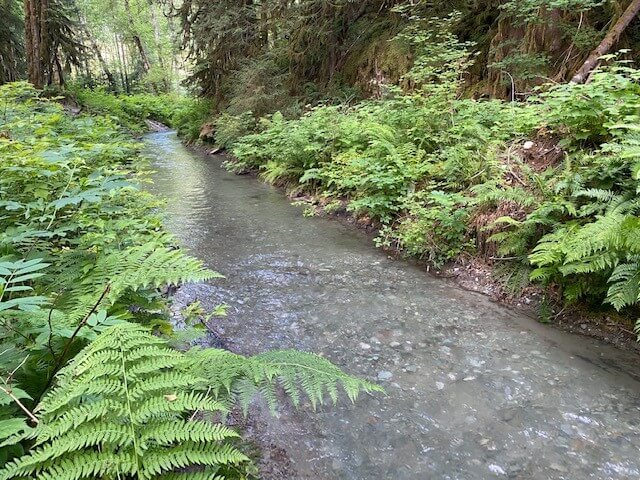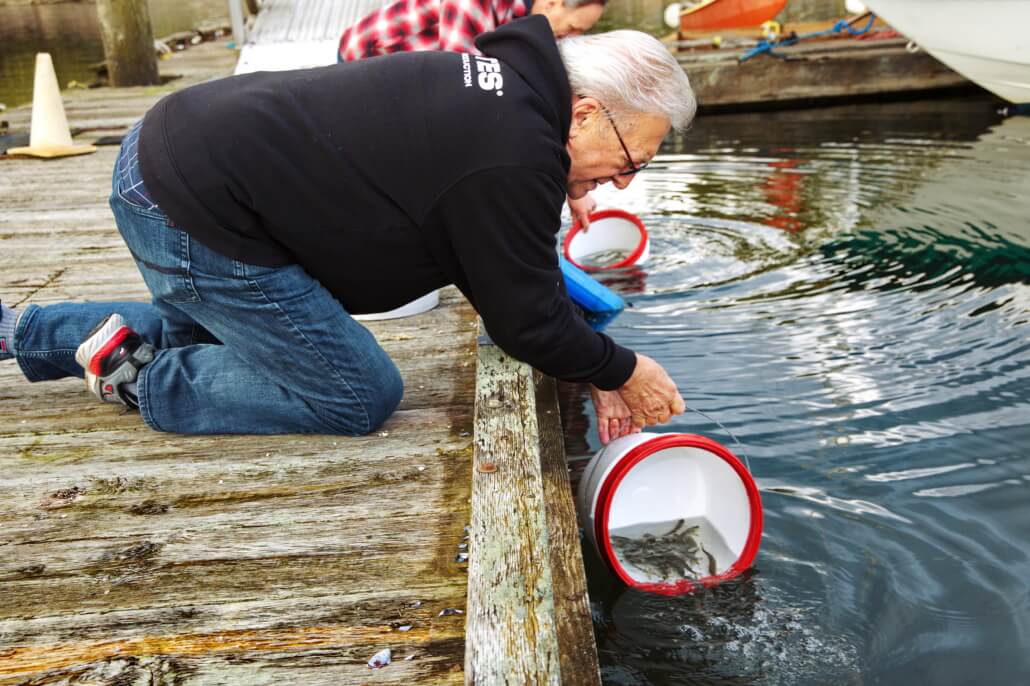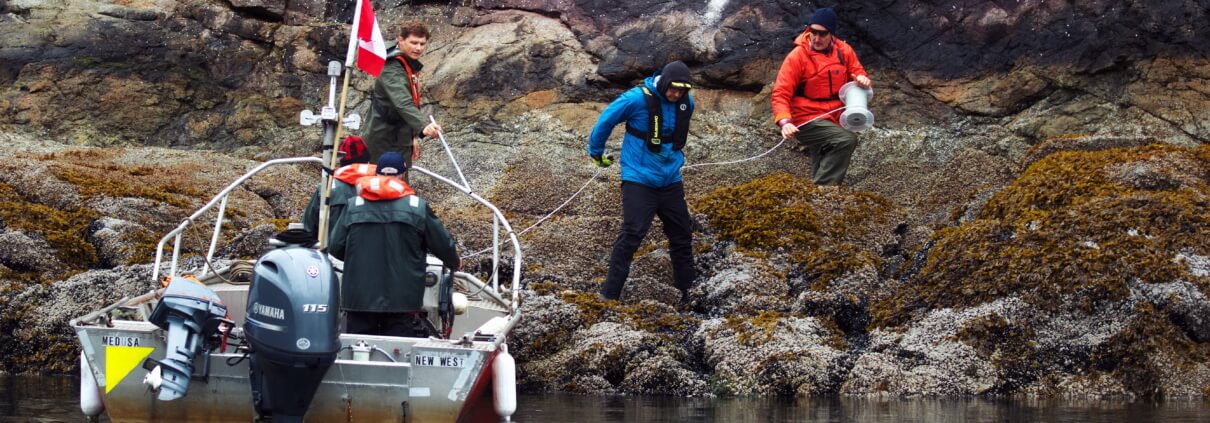Tri-Cities community members step up to save salmon
July 19, 2022
It’s the time of year when salmon start their incredible journey back home from the ocean to their natal streams — many located in the Tri-Cities area of Coquitlam, Port Coquitlam, and Port Moody — to spawn. For Fraser sockeye, this year is especially critical as 2022 is a dominant year, which won’t occur for another four.
Along this journey, salmon endure many challenges including freshwater habitat loss from development, climate change, and other issues.
The Fraser River, the biggest salmon-bearing river in Canada, has suffered from extensive habitat loss and fragmentation issues. The Tri-Cities area is no exception.
Salmon migration up the Fraser and into its tributaries has begun with early runs arriving. To help them reach fertile spawning areas, many volunteers, organizations, and communities are working hard to make a positive difference for salmon. PSF is encouraged by the historical and ongoing efforts by local First Nations, streamkeepers, hatcheries, and conservation groups to restore and improve salmon habitat, monitor and steward populations, and educate the public on the importance of wild Pacific salmon.
“We can support salmon during this portion of their life cycle and give them the best shot at a successful migration by taking thoughtful steps to improve habitat and reverse some of the disturbances,” says Jason Hwang, Pacific Salmon Foundation (PSF)’s VP of Salmon.
Despite the habitat loss, Tri-Cities salmon have persisted in the Fraser and its tributaries.
“Salmon are resilient by nature,” says Hwang. “While many populations are struggling, we’ve seen incredible, often immediate results from habitat rehabilitation and improvement efforts.”
With support from Pacific Salmon Foundation, two local salmon habitat improvement projects in the Tri-Cities area are actively underway through $91,000 in PSF grants. Combined, these projects have a value of $561,425. See below for project details.
Kw’atset te sthe’qi – Corbold Creek South Floodplain Restoration

The Pitt River— which runs adjacent to Port Coquitlam— connects the salmon-bearing Fraser River to the Upper Pitt River watershed, where salmon have suffered from decades of habitat fragmentation. Many salmon populations in the watershed are struggling, some facing record-breaking low return numbers. Upper Pitt sockeye, for example, recently had the lowest returns in 40 years.
Habitat availability is a major limiting factor to salmon productivity in the region. For years, Katzie First Nation and the Lower Fraser Fisheries Alliance (LFFA) have led continued efforts to improve habitat quality for sockeye, Chinook and coho salmon in the Upper Pitt watershed. Last year, the groups created a new 9,924-square-metre Sθqəy spawning channel designed to effectively double the available spawning habitat in this watercourse. This year, the partners are connecting the new channel to the Alvin Patterson Sockeye Spawning Channel, to be used by an estimated 6,000 spawners. This habitat was designed primarily for sockeye, but may also be used by Chinook, pink, and coho salmon, as well as steelhead and cutthroat.
It was essential to complete this phase of the project this year, as Fraser sockeye populations run in abundance every four years and 2022 is an expected dominant year.
“The timeliness of this is critical,” says LFFA fisheries biologist Ian Hamilton. “For any chance at recovering and improving productivity, we need to take advantage of the big cycle years… If we missed this window we’d be waiting four years for the next opportunity, which we weren’t willing to risk.”
The groups anticipate turning on the water flow to the new channel at the beginning of August, and sockeye will typically return to the spawning beds by early September. Stream monitoring and spawner counts will be implemented to assess effectiveness.
Reeve Slough Habitat Reconnection
The Coquitlam River watershed once had abundant stocks of coho, sockeye, Chinook, pink, and chum salmon as well as steelhead and sea-run cutthroat trout. However, dam construction in the early 1900s blocked fish passage to the lake and Upper Coquitlam River and altered the ecosystem of the watershed. By 1969, less than 50 salmon returned to the Coquitlam River watershed.
Since 1993, numerous habitat restoration projects have been completed by various local partners to recover lost habitat. All species of Pacific salmon as well as steelhead and cutthroat have been identified in the Coquitlam River in the years following. Yet there is still a need for more habitat to support the continuing recovery of salmon.
A partnership between Kwikwetlem First Nation, the North Fraser Salmon Assistance Project Society, and Fisheries and Oceans Canada is working to reconnect 31,800 square metres of critical off-channel habitat to the Coquitlam River and create 600 square metres of spawning habitat and 600 square metres of new rearing habitat.
Reeve Slough, a relic channel of the Coquitlam River, is the largest parcel of unrestored, off-channel habitat remaining in the Coquitlam River watershed. Restoration of this site will primarily benefit coho, but would also be accessible to Chinook, chum, sockeye, and pink salmon, as well as cutthroat and steelhead juveniles.
This project will also develop a Kwikwetlem First Nation Five-Year Functional Monitoring and Maintenance Program and a 10-Year Routine Effectiveness Monitoring Program in partnership with the stewardship community, Kwikwetlem First Nation and other Indigenous Communities in the lower Fraser. This project is currently underway and will extend into 2023.
Investigating juvenile survival with tracking technology
Habitat loss isn’t the only challenge salmon swimming upstream through Metro Vancouver waters must confront. Urbanized waters are complex for salmon to navigate, with many challenges including pollution, water traffic, and urban wildlife along their migration. A Port Moody-based conservation group teamed up with a University of British Columbia researcher to track juvenile salmon during their passage through the Vancouver Harbour to improve understanding of what factors might be impacting their survival.
PSF is a long-time supporter of the Mossom Creek Hatchery & Education Centre and contributed funding to this project in support of using technology and innovation to advance salmon conservation.

Releasing tagged coho smolts from the Mossom Creek Hatchery & Education Centre into the Vancouver Harbor in May 2022. (Photo by Paul Steeves)
The Vancouver Harbour presents a variety of predators and challenges for juvenile salmon on their way to the ocean. Mossom Creek Hatchery and Education Centre partnered with UBC’s Dr. Scott Hinch, who is the principal investigator of the Pacific Salmon Ecology Conservation Lab, to study juvenile salmon migration through the harbour.
“They’ve got lots of obstacles,” says Kevin Ryan, president and operations manager of Mossom Creek Hatchery. “They’ve got predation from herons, seals, and cormorants, harbour traffic, hardened shorelines, pollution – you name it. It’s a gauntlet they’ve got to run past.”
Little is known about juvenile salmon movement through the harbour. To better understand the survival of salmon at a critical period of their life as they move through this busy harbour, this team inserted 100 coho smolts with tracking tags and released them into the harbour earlier this spring. As the fish swim, they transmit data to 10 strategically-placed receivers.
This data will reveal how many coho smolts released by local hatcheries are successfully migrating past Vancouver Harbour and into the open ocean. The results, expected to be finalized by this fall, will reveal new information about the extent of harbour impact on juvenile migration and may inform the practice of hatchery releases to improve survival and return rates.
Media inquiries: Photos are available upon request and interviews can be arranged. For more information, contact Braela at bkwan@psf.ca.



